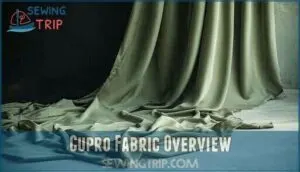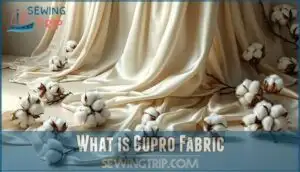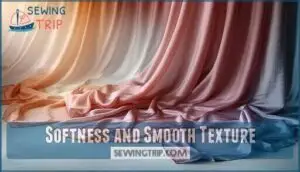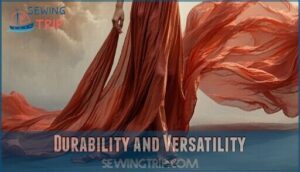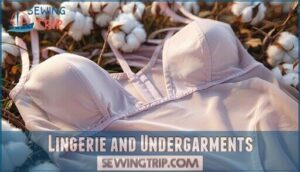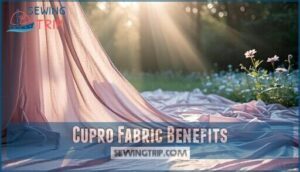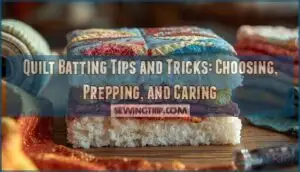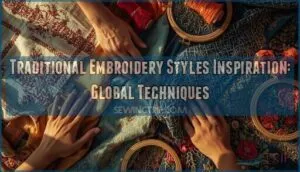This site is supported by our readers. We may earn a commission, at no cost to you, if you purchase through links.
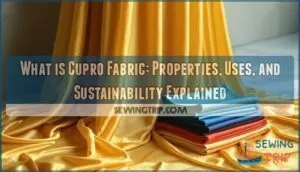 Cupro fabric is a unique, eco-friendly material with impressive properties.
Cupro fabric is a unique, eco-friendly material with impressive properties.
It’s soft and silky, mimicking the feel of high-end silk but without the luxury price tag.
You’ll love its breathability—perfect for keeping cool—and its moisture-wicking abilities make it a favorite for activewear.
Durability is another win for cupro; it resists pilling and wears well over time.
Plus, it holds dye brilliantly, so colors stay vivid.
This fabric is also hypoallergenic and biodegradable, making it a sustainable choice for clothing.
Curious about its versatility or care tips?
There’s even more to uncover about this standout material’s uses and maintenance.
Table Of Contents
Key Takeaways
- You’ll love how cupro feels like silk with its smooth, breathable, and hypoallergenic properties, perfect for sensitive skin.
- It’s eco-friendly, made from recycled cotton waste using a closed-loop system that minimizes environmental impact.
- The fabric resists pilling, holds dye brilliantly for vivid colors, and is durable enough to last through repeated washing.
- While it’s lightweight and versatile for stylish garments, it’s flammable and needs gentle care to prevent shrinking and damage.
Cupro Fabric Overview
Cupro fabric, also called cuprammonium rayon, is a regenerated cellulose material made from cotton linter, a waste byproduct of cotton production.
Transforming cotton waste into elegance, cupro fabric delivers eco-conscious luxury with silk-like softness and sustainable charm.
Known for its silk-like sheen and eco-conscious appeal, it combines softness and breathability with versatility for various clothing applications, making it a desirable choice for those looking for eco-conscious fashion.
Definition and History
Cupro fabric, part of the rayon family, dates back to the early 1900s and was first developed by Swiss chemist Matthias Eduard Schweizer.
Made from cotton linter, a byproduct of cotton production, it’s also called cuprammonium rayon or Bemberg, after the brand that crafts it.
This "vegan silk" mimics silk’s elegance using recycled cotton and cellulose, blending sustainability with luxury.
Today, Japan’s Asahi Kasei exclusively produces it, continuing its legacy under the renowned Bemberg trademark.
Production Process
Transforming cotton waste into luxury, cupro fabric production starts by dissolving cellulose from cotton linters in a cuprammonium solution of copper and ammonia.
Turning cotton waste into luxury, cupro fabric embodies eco-conscious elegance through its unique transformation process with copper and ammonia.
This viscous mix is extruded through spinnerets into caustic soda, forming fine filaments.
Excess chemicals are removed, and the fibers are woven.
Modern closed-loop systems optimize chemical usage, reuse copper and ammonia, and minimize waste.
-
Key Steps:
- Cellulose dissolution
- Fiber extrusion
- Chemical recovery
- Filament solidification
- Energy-efficient scalability
Sustainability Aspects
Thinking about sustainable fashion, cupro fabric offers promising solutions.
This ecofriendly textile transforms cotton linter, a byproduct of cotton processing, into something luxurious while reducing waste.
Plus, advanced closed-loop systems recover harmful chemicals during production, making the process cleaner.
Some manufacturers even incorporate renewable energy, further lowering the environmental impact.
While concerns about water consumption still linger, its natural biodegradability and focus on textile recycling make it a standout material in the push for sustainable fabric alternatives.
What is Cupro Fabric
It’s fascinating how waste becomes luxury with cupro fabric. Born from cotton linters—tiny fibers too short for traditional use—this textile elevates leftovers into something extraordinary through a unique cuprammonium process. Known as part of the rayon family, cupro offers the elegance of silk without the hefty price tag or animal-derived origins, making it a popular Bemberg alternative.
Take a look at how cupro stands out:
| Cupro Composition | Production Location | Fabric Properties |
|---|---|---|
| Regenerated cellulose | Mainly in Japan | Silky-smooth and breathable |
| Cotton linters | Originally Germany | Lightweight and biodegradable |
| Vegan silk | Trademark: Bemberg | Drapes like silk, eco-friendly |
| Cuprammonium rayon | Modern Chinese name | Comfortable for all seasons |
| Plant-based fibers | Asahi Kasei leader | Gentle, ideal for sensitive skin |
Cupro fabric characteristics include softness, luxurious drape, and eco-conscious origins. As a natural fiber, it’s known for breathability and durability, making it a comfortable choice. Known by various fabric names like “ammonia silk”, it’s a fantastic option for sustainable, stylish clothing.
Cupro Fabric Characteristics
When you think about Cupro fabric’s characteristics, you’ll notice its luxurious softness, silky smooth texture, and breathability that feels kind to your skin.
It offers durability, versatility, and eco-friendly qualities, making it both practical and sustainable for various uses.
Softness and Smooth Texture
The silky alternative, Cupro, delivers an unmatched velvety handfeel and flows effortlessly across your skin.
This standout feature of cupro fabric characteristics redefines luxurious feel, making it perfect for sensitive skin.
Its softness is a hallmark of cupro fabric properties, offering indulgence in every touch.
- Feels like silk but more breathable.
- Offers drape quality for elegant outlines.
- Gentle enough for **sensitive skin types.
- Enhances the luxury of any garment it graces.
- A versatile fabric for refined tastes.
Breathability and Moisture-Wicking
Feel cool and confident with cupro fabric breathability and moisture-wicking.
It’s perfect for tackling hot, sticky days.
Cupro fabric breathability lets air flow freely, while its moisture absorption pulls sweat off your skin with ease.
| Feature | Performance |
|---|---|
| Breathability | Excellent |
| Moisture absorption | High |
| Sweat management | Steady |
| Skin comfort | Superior |
Stay fresh, dry, and comfortable—cupro is your wardrobe’s secret weapon.
Durability and Versatility
Cupro fabric stands out for its durability and versatility, creating garments that handle everyday wear beautifully.
While not as tough as some rayon alternatives, it balances tear resistance and abrasion resistance remarkably well. Plus, its blending options enhance strength and texture effortlessly for different fabric uses. Considering the fabric’s GSM, its weight contributes to its overall resilience.
- Maintains garment lifespan through superior weave stability
- Resists wear despite repeated washing, adding value to wardrobe staples
- Shifts seamlessly across seasons and style preferences
- Perfect for everything from evening gowns to casual, breathable outfits
Cupro fabric durability makes it a smart, stylish choice for long-lasting clothing that performs beyond expectations.
Eco-Friendly Properties
Cupro stands out for its eco-friendly textiles and sustainable fashion appeal.
It’s produced in a closed-loop system, reusing waste cellulose to minimize environmental impact.
Beyond its biodegradability factor, cupro fabric sustainability gains recognition for reducing toxins during crafting.
Although chemical impact remains a concern, innovative practices are enhancing this process.
As a champion among ecoconscious textiles, cupro aligns with sustainable certifications, making it a smart choice for those embracing responsible, eco-friendly textiles.
Cupro Fabric Uses
You’ll find cupro fabric used in everything from elegant dresses to lightweight activewear, thanks to its soft texture and breathable nature.
Its versatility also makes it a favorite for lingerie, linings, and stylish fashion accessories, which showcases its versatility.
Formal Apparel and Dresses
Cupro fabric’s elegance makes it perfect for formal apparel and dresses, especially with its silk-like drape and luxurious feel.
Its versatility shines in ethical gowns and wedding dresses, combining style with sustainability.
Here’s where you’ll notice its charm:
- Flowing evening wear that drapes beautifully.
- Bridal dresses that feel light yet structured.
- Formal blouses and dress linings boasting subtle shine.
For autumn or winter events, consider velvet for richness. Cupro fabric uses redefine sophistication and offer a unique luxurious feel!
Sportswear and Activewear
Step up your game with Cupro performance in activewear blends that redefine workout gear.
This sustainable sportswear keeps you cool and dry with superior moisture-wicking and moisture management abilities, while offering unmatched Cupro comfort.
Its impressive stretchability guarantees unrestricted movement, perfect for yoga and running.
Plus, the durable cupro fabric reliably holds up through repeated washes, making it a top choice for performance-driven apparel enthusiasts who value comfort and longevity.
Lingerie and Undergarments
In the context of lingerie, cupro fabric stands out.
Its softness feels luxurious against your skin, offering unmatched Cupro Comfort.
Thanks to its breathable nature, you’ll stay fresh all day.
The lightweight Cupro fabric drape complements elegant designs, while its ethical production makes your Sustainable Underwear guilt-free.
Plus, blended fabrics with Cupro enhance durability.
-
Key Benefit:
- Breathable lingerie crafted from ethically sourced materials blends comfort and style seamlessly.
Fashion Accessories and Textiles
When you’re after accessories that mix elegance with practicality, cupro fabric delivers.
Its soft, luxurious texture makes it ideal for scarves, ties, and shawls, offering the feel of affordable luxury.
Textile blends enhance its durability while keeping that signature smoothness.
Even lining fabrics and eco-friendly handbags benefit from its versatility.
With standout fabric properties like excellent drape and moisture-wicking, Cupro elevates both style and function, making it perfect for ethical gowns, summer dresses, and more.
Cupro Fabric Properties
In the context of properties, Cupro fabric checks all the right boxes with its smooth texture, excellent dye retention, and gentle elasticity.
You’ll also appreciate its ability to resist pilling and maintain color vibrancy, making it both practical and luxurious for various uses.
Great Dye Retention and Colorfastness
In achieving vibrant, long-lasting colors, cupro fabric excels in fabric dyeing.
Its natural fabric properties guarantee exceptional color retention and fade resistance.
Here’s why it stands out:
- Dyeing Process: Absorbs hues evenly.
- Color Vibrancy: Brings bold shades to life.
- Fade Resistance: Handles repeated washing gracefully.
- Wash Durability: Maintains brilliance.
- Lightfastness: Resists sunlight fading.
Heat Retention and Insulation
Feeling chilly in winter or overheated in summer? Cupro fabric’s Warmth Factor has you covered.
Its fabric insulation balances body temperature, keeping you snug during cold months yet breathable in heat.
Designed for Seasonal Use, its moisturewicking properties efficiently handle sweat, ensuring dryness and comfort.
Plus, Layering Options make it a versatile choice for any climate.
With Climate Adaptability built-in, cupro fabric promises effortless year-round comfort without compromising its luxurious feel.
Stretchiness and Elasticity
Stretchiness in cupro fabric adds subtle flexibility, balancing comfort with durability.
Its elasticity limits prevent sagging while maintaining shape, texture, and a polished garment fit over time.
The blending effects of cupro with other fibers, combined with its weave impact, enhance breathability and moderate fabric stretchability.
- Supports lightweight designs with graceful draping.
- Recovers well after movement, ensuring consistent fabric stretch.
- Perfect for form-fitting yet breathable clothing.
Pilling and Bubbling Resistance
Cupro fabric resists pilling and bubbling thanks to its tightly packed fibers and smooth finish.
Proper care, like gentle washing, keeps the weave dense, extending garment life.
Its sleek look and durability result from fiber blends and abrasion tests during production.
As a natural fiber, cupro offers enhanced airflow and comfort compared to many synthetics.
Here’s a quick view of its characteristics:
| Factor | Cupro Benefits | Cupro Disadvantages |
|---|---|---|
| Pilling Causes | Minimal | Risks increase with rough washing |
| Bubbling Prevention | High durability | Requires careful maintenance |
| Fiber Blends | Enhances strength | May reduce elasticity |
| Weave Density | Boosts longevity | Sensitive to certain detergents |
| Abrasion Tests | Superior results | May weaken if misused |
Cupro Fabric Care
Taking care of Cupro fabric isn’t complicated, but it does require a gentle touch to maintain its smooth texture and elegant drape.
Understanding the right washing methods, drying techniques, and storage tips will help you keep your garments looking their best.
Washing Instructions and Machine Washing
For the best results, wash cupro fabric on a delicate cycle using cold water to avoid shrinking.
Place garments in mesh bags for extra protection and opt for a mild, bleach-free detergent. You may want to think about a specialized cleaning solution for best results.
Avoid high-speed spins, which can stress the fibers. Stick to gentle drying methods like air drying flat or on a rack.
Follow these fabric care instructions, and your machine washable cupro will stay smooth and vibrant, by using mild detergent and following the recommended delicate cycle and drying methods.
Dry Cleaning and Special Care
When tackling delicate cupro fabric, professional cleaning is a smart option to maintain its silky texture and durability.
For stains, try stain removal with talcum powder on oil marks before professional help. Always review care labels, as fabric washing instructions vary.
Don’t overdo dry cleaning—occasional sessions suffice in preventing damage. Consider using specialized cleaning products to maintain the fabric’s integrity.
Avoid harsh chemicals during restoration techniques to preserve quality. Focus on gentle treatments to safeguard against shrinking, ensuring longevity and fabric care perfection.
Ironing and Steaming Techniques
Don’t let wrinkles cramp your style when caring for cupro fabric.
Use a low iron temperature, setting your iron to the "silk" option for gentle touch. Always place a pressing cloth for fabric protection.
Prefer steaming methods? Handheld steamers are perfect for wrinkle removal without harsh contact. You can find specialized ironing products for cupro.
- Low iron temperature prevents damage during fabric ironing.
- Handheld steamers keep the fabric’s soft texture intact.
- Wrinkle resistance means less frequent touch-ups!
Storage and Maintenance Tips
Wondering how to store cupro fabric properly? Focus on care specifics. Fold lighter garments or hang structured ones to prevent creases.
Protect against moths with cedar or lavender. Control humidity—avoid damp spots. Handle stains right after cupro fabric washing.
For long-term storage, follow care tips for sheen restoration and prevent fabric shrinking. Use this table for quick guidance:
| Task | Method | Tools Needed | Cautions |
|---|---|---|---|
| Proper Folding | Fold for light items | Clean surface | Avoid over-folding |
| Humidity Control | Use dry spaces | Dehumidifier | Check monthly |
| Moth Prevention | Cedar/lavender sachets | Sachets | Replace as needed |
| Stain Removal | Immediate treatment | Mild detergent | Avoid strong acids |
Cupro Fabric Benefits
When you explore cupro fabric, you’ll find it offers an impressive combination of sustainability, comfort, and versatility.
Its eco-friendly production, hypoallergenic qualities, and wide range of uses make it an excellent choice for various clothing and accessory needs, highlighting its versatility.
Sustainable and Eco-Friendly Advantages
Cupro fabric is a green game-changer, made from waste cellulose using closed-loop systems.
Its chemical recycling process minimizes environmental impact while enhancing sustainability.
As an ecofriendly textile, it’s biodegradable, reducing landfill load and promoting sustainability.
Compared to others, reduced water usage highlights its value as a sustainable alternative.
With cupro, luxury meets responsibility—an elegant choice for mindful fashion.
Health Benefits and Hypoallergenic Properties
Shifting from eco-friendly perks to your personal care, cupro fabric—also called Cuproammonium rayon—offers unmatched skin sensitivity benefits.
Its hypoallergenic properties make it ideal for those with sensitive skin, greatly aiding allergen reduction.
The fabric’s microbial resistance helps control odors, while its breathability benefits keep you cool and fresh.
Cupro feels incredibly soft, almost like a whisper against your skin, offering exceptional comfort factors for daily wear.
Bonus? It’s vegan-friendly, blending luxury and practicality in one skin-loving, wellness-forward material.
Cost-Effective and Affordable Options
You’re smart to think about cupro fabric when exploring budget-friendly materials.
It blends luxury with affordability, making it a standout among fabric alternatives.
Here’s why it works:
- Low fabric cost from recycled materials.
- Offers softness rivaling silk, minus the price tag.
- Eco-friendly production reduces waste, cutting costs.
- Perfect for budget apparel and affordable blends.
- A true cost-effectiveness gem for fashion-conscious shoppers.
Versatility and Wide Range of Applications
This fabric opens doors to limitless fashion applications, blending style and sustainability.
Its unique properties make it a favorite for diverse uses:
- Formal Gowns: Perfect for ethical weddings and sophisticated events.
- Activewear Uses: Lightweight and breathable for comfort during workouts.
- Lingerie: Soft and gentle against the skin.
- Accessory Textiles: Elevate scarves, ties, and more.
- Home Textiles: Luxurious drapes and bedding highlight its versatility.
Cupro blends redefine modern, eco-conscious fashion.
Frequently Asked Questions (FAQs)
What are the disadvantages of cupro?
It’s like a double-edged sword: while sleek and luxurious, cupro is fragile, flammable, and prone to pilling.
It shrinks in dryers, struggles with dyes, and its chemical-heavy production raises environmental concerns, making environmental concerns a significant issue.
Can cupro go in a washing machine?
Yes, you can wash cupro in a machine, but stick to a delicate cycle, cold water, and a mesh laundry bag.
Avoid hot water or dryers; air drying flat keeps it looking great longer.
Is it safe to wear a cupro?
Wearing cupro feels as smooth as a gentle breeze on your skin.
It’s safe, breathable, and hypoallergenic, making it a great choice for sensitive skin.
Just handle it with care—it’s delicate!
Does cupro shrink in the wash?
Cupro can shrink if you’re not careful.
Always use cold water and a delicate cycle for washing. Avoid dryers; air dry it flat instead.
Heat and improper handling are the culprits behind shrinkage.
Is Cupro fabric vegan and cruelty-free?
You’ll be glad to know that Cupro is vegan and cruelty-free.
Since it’s plant-based, made from recycled cotton or plant cellulose, it doesn’t involve animals, making it a great ethical fabric choice.
Is Cupro fabric machine washable?
Throw your fabric care fears out the window—most Cupro fabrics can handle machine washing.
Use the delicate cycle with cold water, toss it in a mesh bag, and air dry flat for best results.
Can Cupro fabric be dyed?
You can dye Cupro fabric, but it’s tricky due to its chemical treatments.
Use fabric dyes designed for cellulose fibers, and always test a small area first, as colors mightn’t absorb evenly.
Does Cupro fabric have any certifications?
Cupro fabric itself doesn’t typically carry specific certifications.
However, manufacturers like Asahi Kasei often use closed-loop production methods and renewable energy, which might meet certifications related to sustainability or eco-friendly processes, depending on standards.
Is Cupro fabric easy to ignite?
Think of a dry leaf by a campfire—it catches flame quickly.
Similarly, this fabric ignites easily above 180°C, making it flammable.
Handle it cautiously, especially around open flames or high heat sources.
Is cupro fabric suitable for cold climates?
Cupro fabric isn’t ideal for cold climates.
While soft and breathable, it’s lightweight and lacks insulation.
You’d feel more comfortable pairing it with wool or thermal fabrics to stay warm and cozy.
Conclusion
Picture your wardrobe as a toolbox—cupro fabric is the Swiss Army knife you didn’t know you needed.
With its soft, silky texture, breathability, and hypoallergenic nature, it checks all the boxes for comfort and style.
Its durability, moisture-wicking properties, and sustainability make it stand out in a crowded market.
If you’re wondering what is cupro fabric properties, it’s a blend of practicality and eco-consciousness.
Embrace it for versatile, vibrant, and eco-friendly wardrobe staples you’ll love.

